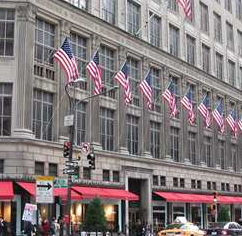Articles and News
LUXURY RETAIL RENTS SPIRALING June 29, 2011 (0 comments)

Merrick, NY—According to this article in The Nation citing data from Colliers International, as consumers return to luxury spending, rents for prime real estate in tony shopping districts around the world also are bouncing back to pre-recession levels. With consumer confidence boosting the luxury market and investor confidence boosting luxury brand stock prices like Richemont-Cartier and Tiffany, landlord confidence is boosting rent—in some places by as much as 72% year-over-year.
The priciest retail real estate in the world is Fifth Avenue in New York, shown here, where the $2,150/sq. ft. price (as of March 2011) not only is indeed 72% higher than last year, it booted Paris’ Avenue des Champs Elysees, the former most expensive slice of real estate, down to number eight in global ranking. Compare this with the national average rental rate (comprising all retail, not just luxury) of $14.86 per square foot per year as of Q1 2011, according to CoStar Group’s National Retail Market Overview.
Other retail high spots include Hong Kong’s Russell Street in Causeway Bay, where rents climbed 25.6% to US $1,510 per square foot per year, Tverskaya Street in Moscow, up 21.3%, Zurich’s Bahnhofstrasse, up 14.2%, and Sydney’s Pitt Street Mall, up 11.1%. Both the Champs Elysees and London’s Old Bond Street remained solidly expensive, but unchanged from last year. Tokyo’s Ginza-Chuo Avenue and Singapore’s Orchard Road also remained stable, but other luxury shopping corridors across Asia recorded increasing rents ranging from 6%-29% year over year.
In the United States, apart from the spike in Fifth Avenue figures, more modest increases were posted for other parts of New York City (including next-block-over Madison Avenue), Chicago’s North Michigan Avenue, and San Francisco’s Union Square district. The famous Rodeo Drive in Beverly Hills, CA showed only a very tiny increase and, in Canada, both Bloor Street in Toronto and Robson Street in Vancouver held steady.
Colliers chief economist for USA business and global report author Ross J. Moore said in the article that much of the luxury rebound comes from aspirational spending—consumers who buy luxury in small increments at a time—but he told The Centurion that was more global in nature than American.
“I don't think the US luxury shopper is aspirational. I really think it's an Asian phenomenon, and central and eastern European, and Latin American to a lesser extent,” he told The Centurion.
According to the CoStar report, the total retail vacancy rate for the first quarter of 2011 was just above 7%. Shopping centers—including strip centers, small neighborhood centers and larger community centers—have the highest vacancy rate, at just below 11%. General retail (i.e. Main Street) has the lowest, at 5%, followed by malls, just under 6%.







